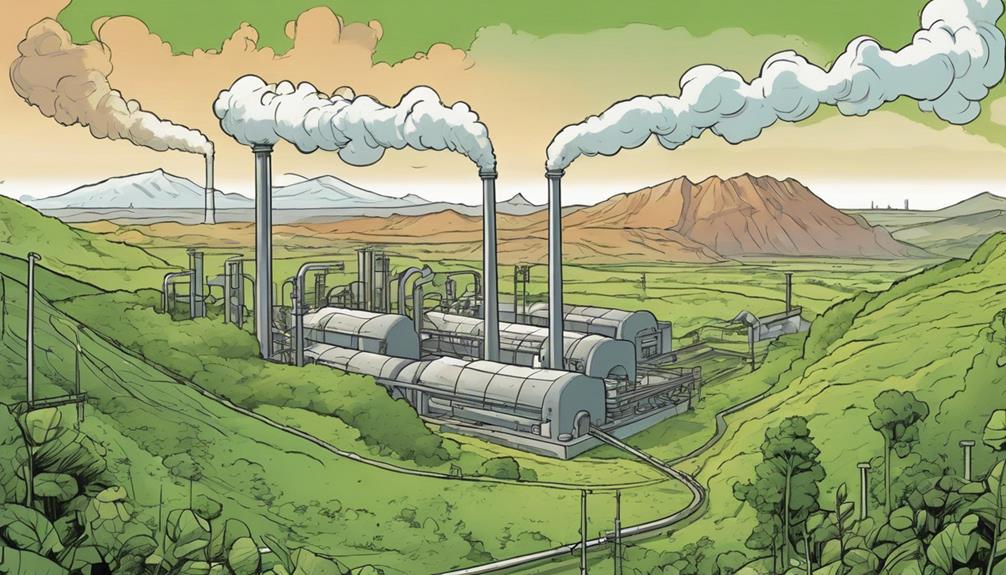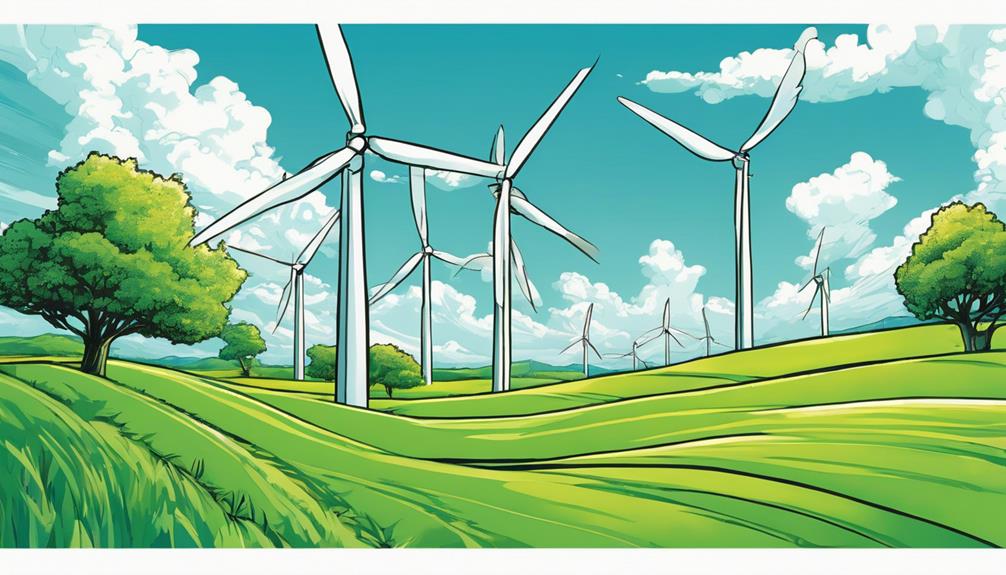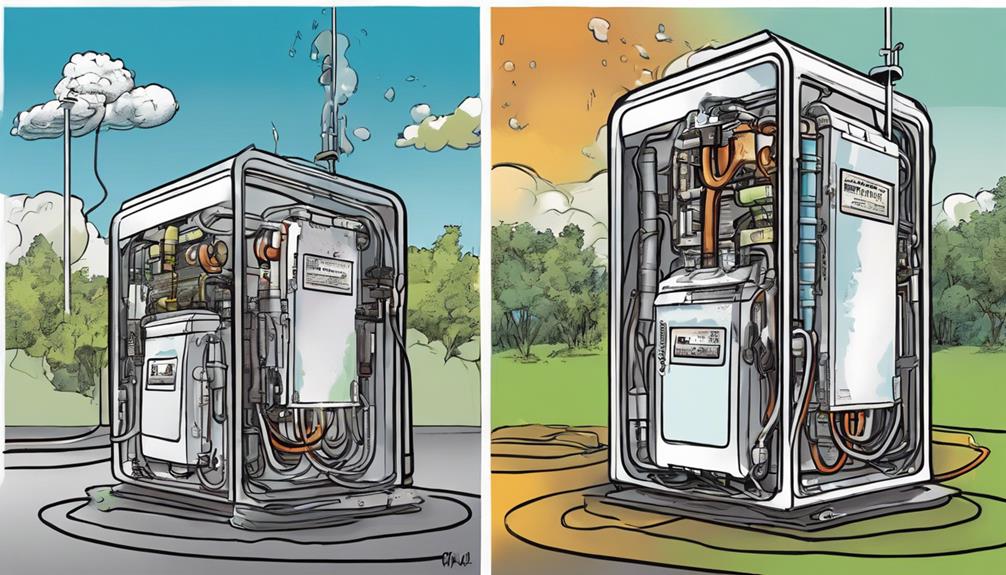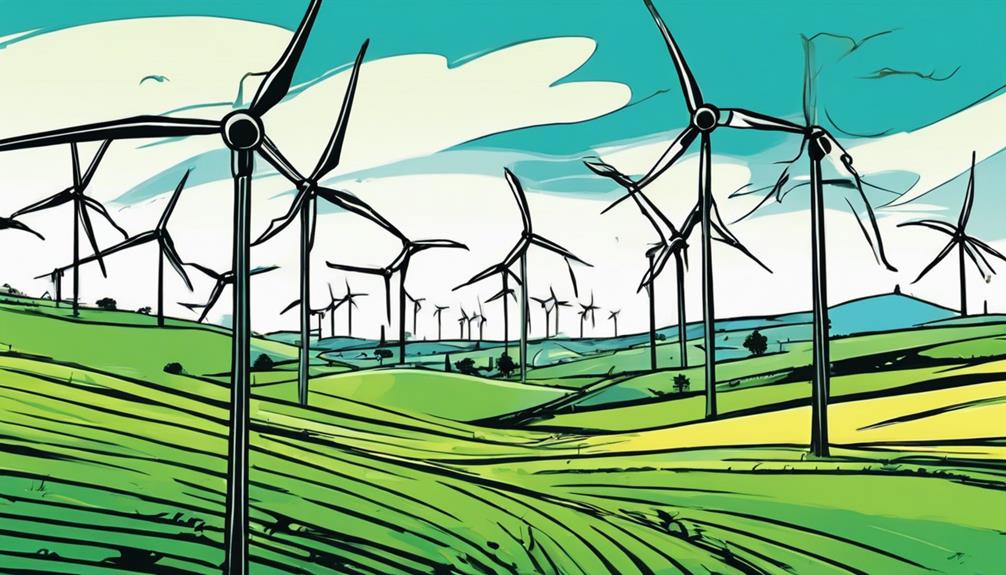We're harnessing the Earth's natural heat to generate power, and it's a game-changer for the planet, offering a cleaner, more efficient alternative to traditional energy sources. Geothermal energy greatly reduces our carbon footprint, minimizes greenhouse gas emissions, and produces minimal air emissions, improving air quality. It's also an efficient use of natural resources, with low water consumption and high efficiency in converting Earth's heat to electricity. But, like any energy source, it's not without its challenges. Let's explore the benefits and complexities of geothermal energy and how it can shape our sustainable future. Geothermal energy also has the potential to create jobs and stimulate economic growth in the regions where it is harnessed. However, there are some concerns about the impacts of biomass pollution and the potential for induced seismic activity. Despite these challenges, the potential for geothermal energy to play a significant role in our transition to a sustainable future is undeniable. By investing in research and development, we can continue to overcome these challenges and fully realize the environmental and economic benefits of geothermal energy.
Key Takeaways
- Geothermal energy greatly reduces carbon footprint and minimizes greenhouse gas emissions, producing minimal air emissions and improving air quality.
- Efficient use of natural resources is achieved through low water consumption, high efficiency in heat-to-electricity conversion, and minimal land use.
- Environmental challenges, such as soil erosion and habitat destruction, can be mitigated through control measures and environmental impact assessments.
- While geothermal energy poses some public health risks, mitigation measures can address breathing problems, skin sensitivity, and neurological impacts.
- Geothermal energy has economic viability and global potential, with cost-competitive potential and enhanced systems expanding suitability in various regions.
Environmental Advantages of Geothermal

We can greatly reduce our carbon footprint by harnessing geothermal energy, which minimizes greenhouse gas emissions and produces minimal air emissions, thereby improving air quality.
This sustainable source of energy consumption is remarkably low and often recycles water, reducing water demand.
With proper land management practices, geothermal energy has minimal environmental impact compared to fossil fuels.
In fact, geothermal power plants have lower water consumption than fossil fuel plants, and the water used is often recycled, reducing overall demand.
Efficient Use of Natural Resources

As we endeavor to maximize the benefits of geothermal energy, we're finding that it's not only good for the planet, but also remarkably efficient in its use of natural resources, converting Earth's heat into electricity with minimal waste and environmental disruption.
Here are just a few reasons why geothermal energy stands out:
- Low water consumption: Geothermal power plants have lower water consumption than fossil fuel plants, making it an attractive option for water-scarce regions.
- High efficiency: Geothermal energy is highly efficient in converting Earth's heat to electricity, reducing energy waste and minimizing environmental impact.
- Recycled water: Water used in geothermal systems is often recycled, reducing overall demand and preserving this precious resource.
- Minimal land use: While geothermal energy development requires some land disturbance, the impact is minimal compared to traditional power generation methods.
Land Use and Development Challenges

We must acknowledge that geothermal energy development can cause significant land disturbance, disrupting natural landscapes and potentially leading to soil erosion and habitat destruction. As we weigh the benefits of geothermal energy, we must also consider the impact on the land. Drilling deep wells for geothermal plants can alter the natural terrain, causing fragmentation of ecosystems and loss of biodiversity.
| Land Use Impact | Mitigation Strategy |
|---|---|
| Soil Erosion | Implement erosion control measures |
| Habitat Destruction | Conduct environmental impact assessments |
| Land Fragmentation | Restore habitats and ecosystems |
| Visual Pollution | Design plants to blend with surroundings |
Public Health Implications and Risks

While geothermal energy's environmental benefits are undeniable, we must also consider its potential impact on public health, as even minimal air emissions can pose risks to nearby communities. Although geothermal power plants produce minimal air emissions, exposure to these emissions can still cause health issues. Recognizing these risks and implementing measures to mitigate them is crucial.
Here are some potential health risks associated with geothermal energy:
- Breathing problems: Inhaling geothermal emissions can irritate the lungs and worsen existing respiratory conditions.
- Skin sensitivity: Exposure to geothermal emissions can result in skin rashes and sensitivity.
- Neurological impacts: In rare instances, geothermal emissions can influence the nervous system, leading to headaches, dizziness, and fatigue.
- Elevated cancer risk: Prolonged exposure to geothermal emissions may heighten the likelihood of specific types of cancer.
Economic Viability and Global Potential

Geothermal energy's economic viability relies on its ability to compete with other renewable energy sources, and its global potential is heavily influenced by regional geology and heat flow.
We've observed that initial high upfront costs can pose a significant barrier to large-scale geothermal energy projects. However, we believe that geothermal energy can be cost-competitive with other renewables, making it a viable option for many regions.
Enhanced geothermal systems (EGS) have the potential to expand geothermal energy's reach to more areas, increasing its global suitability.
As we move forward, it's crucial to take into account local geology and heat flow when determining the feasibility of geothermal projects. By doing so, we can realize the full potential of geothermal energy and make it a more significant contributor to our global energy mix.
Frequently Asked Questions
How Does Geothermal Energy Compare to Other Renewable Energy Sources in Cost?
We find that geothermal energy is cost-competitive with other renewable energy sources, making it a viable option; however, high upfront costs can be a barrier to large-scale projects, limiting its widespread adoption.
Can Geothermal Energy Be Used for Heating and Cooling Buildings Directly?
"Can we imagine a world where buildings are heated and cooled naturally? We can, with geothermal energy Since it harnesses Earth's heat, we can use it for direct building heating and cooling, reducing our reliance on fossil fuels."
Are Geothermal Power Plants Prone to Natural Disasters Like Earthquakes?
We're aware that geothermal power plants can be vulnerable to natural disasters like earthquakes, which can damage facilities and disrupt operations, but robust design and safety measures can mitigate these risks.
How Long Does It Take to Build a Geothermal Power Plant From Start to Finish?
'We're excited to delve into the timeline of building a geothermal power plant. From start to finish, it typically takes around 5-10 years, depending on factors like project complexity and environmental permitting.'
Can Geothermal Energy Be Used to Power Electric Vehicles Directly?
We can't directly power electric vehicles with geothermal energy, but we can use it to generate electricity, which can then be used to charge those vehicles, reducing our carbon footprint in the process.
How Does Geothermal Energy Maintenance Impact the Environmental Benefits?
Geothermal energy cost savings play a crucial role in maintaining the environmental benefits of geothermal energy. By reducing the overall operation and maintenance expenses, the impact on the environment is minimized. This allows for a more sustainable and eco-friendly energy source that can continue to provide clean power for generations to come.
Conclusion
As we venture further into the domain of geothermal energy, we uncover a paradox – a clean, efficient, and abundant resource, yet one that's not without its challenges. We've weighed the benefits of reduced emissions and minimal water usage against the drawbacks of land disturbance and public health concerns.
One theory stands out: geothermal energy can be a game-changer if we can overcome the economic hurdles. The truth? Investing in research and development can reduce costs by up to 50%.
The future of geothermal energy looks bright, and it's time to take the leap.










